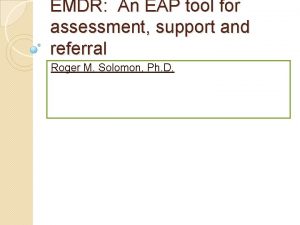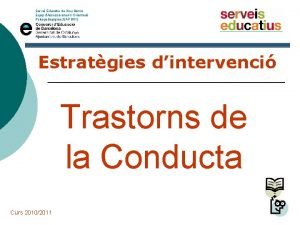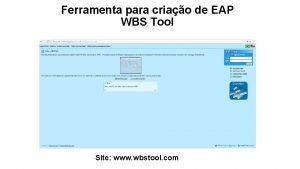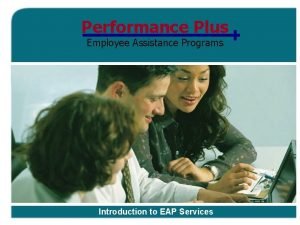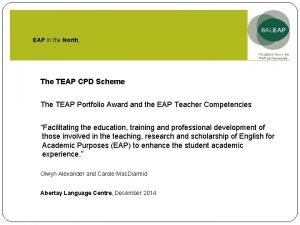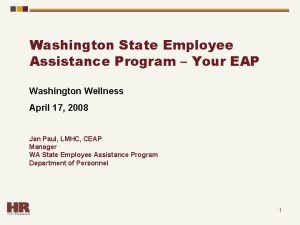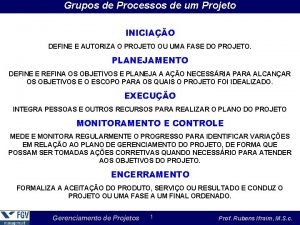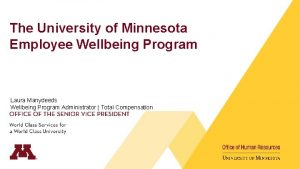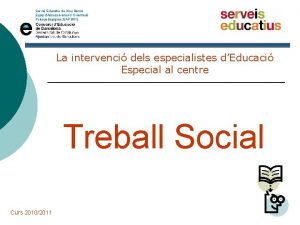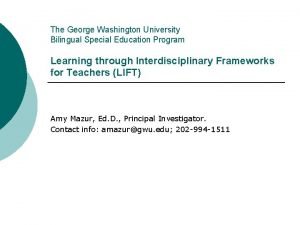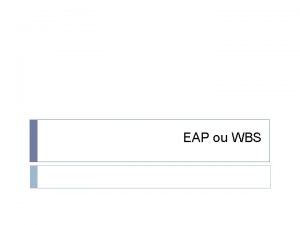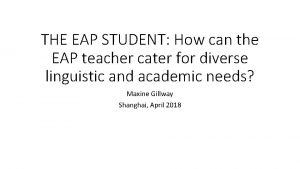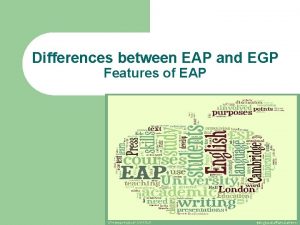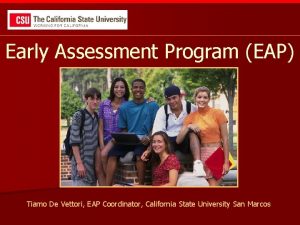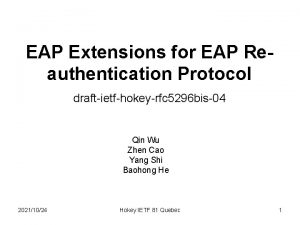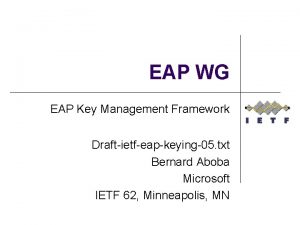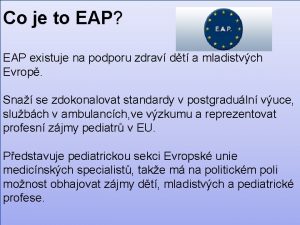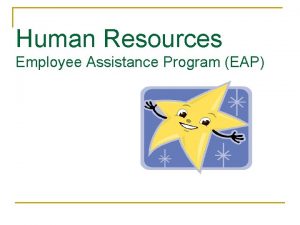Increasing Seminar Participation Lessons from EAP for Everyone





![Importance of Seminar Participation for Academic Success � [F]aculty believe that the behaviors most Importance of Seminar Participation for Academic Success � [F]aculty believe that the behaviors most](https://slidetodoc.com/presentation_image_h/37b1725e31e84f110a1ed362d48161c3/image-6.jpg)














- Slides: 20

Increasing Seminar Participation: Lessons from EAP for Everyone Dr. Ellie Kennedy Nottingham Trent International College Student Writing in Transition Symposium NTU 13 th Sept, 2011

Brainstorm � What is the purpose of a seminar? � How do/should students learn in a seminar? � What particular problems might international students face in seminars at a UK university?

Some Purposes of Seminars �Explore, question and process key concepts (e. g. from lectures and readings) �Active/interactive learning through group tasks, small group discussions, whole-class discussion, student presentations etc. �Tutor can identify and address problems/gaps �Direct access to tutor for questions and help

International Students in Transition �school to university �home culture to UK culture �one education system to another �(often) from learning in their own language to learning in English.

Some Typical Problems for International Students in Seminars �Difficulty following the discussion �Difficulty expressing own ideas �Difficulty understanding materials used (e. g. case studies) �Difficulty understanding task instructions �Unused to speaking out in class �Unused to group learning/expect to receive ‘knowledge’ from the tutor �Unused to questioning others’ ideas
![Importance of Seminar Participation for Academic Success Faculty believe that the behaviors most Importance of Seminar Participation for Academic Success � [F]aculty believe that the behaviors most](https://slidetodoc.com/presentation_image_h/37b1725e31e84f110a1ed362d48161c3/image-6.jpg)
Importance of Seminar Participation for Academic Success � [F]aculty believe that the behaviors most responsible for impeding international students’ academic success are: (a) their lack of participation in classroom discussions, (b) their lack of participation in debate with classmates or instructors, and (c) their failure to ask for clarification of issues. . . that are unclear (Tompson & Tompson, 1996). Ø These are seminar-style habits Ø Improving seminar performance -> improving (international) student experience

Internationalisation �Recruiting more international students �International content for modules �EAP courses, e. g. teach seminar skills to international students Ø We could also internationalise teaching styles to focus on international students’ learning needs, even in subject modules/ seminars.

Example: Case Study and Questions from Business Seminar � Students are given a 3 -page case study New Coke: A Classic Brand Failure, and asked to answer the following questions: 1. 2. 3. 4. The launch of New Coke turned out to be a nightmare for Coca-Cola. Discuss the marketing implications of introducing New Coke. Was it necessary to re-formulate New Coke? Where did market research fail in this case? What would you do if you were a market researcher? Class Debate: do you think the New Coke launch was a tactical market manoeuvre or an unintentional mistake? Give your opinion and substantiate it. � What problems might international students experience if given these in a seminar?

Case Study – New Coke: A Classic Brand Failure Original lesson plan: 1. Tutor reads 3 -page case study aloud to class 2. Students use case study to write answers to the accompanying questions 3. Whole-class debate on ‘was new Coke a tactical manoeuvre or a mistake’? ‘Ideal’ students can �read the text quickly �understand the content easily �critically engage with the issues immediately

An EAP-Style Approach EAP professionals: �Attuned to the particular needs of international students �Used to adapting materials for international students Ø EAP approaches can be used productively for academic subjects to increase participation from international and home students

Brainstorm The case study New Coke: A Classic Brand Failure concerns Coke’s replacement of their traditional recipe with the sweeter ‘New Coke’. The new product, however, resulted in a lower market share as consumers were emotionally attached to the old brand, contrary to the results of blind taste tests. Coke then reintroduced their old recipe as ‘Classic Coke’ and regained their place as market leader. The tutor wants students to discuss whether the new formula was a mistake or a shrewd marketing manoeuvre. � How would you approach this material for a class of home and international students to maximise critical engagement with the material?

Steps Towards Critical Engagement Some suggested steps for secondlanguage students: �Focus (main idea) �Language (key terms for comprehension and discussion) �Understanding Content �Thinking (about the key concepts/questions) �Engagement (e. g. discussion)

1. Focus Three-page text can be intimidating. Before reading, prepare the topic and give a focus: � Warmer questions before reading, e. g. : ▪ do you like to drink Coke? ▪ what is failure? ▪ what brands do you love? ▪ how would you feel if your favourite product changed?

2. Language � Plan a task to help students identify key words; help them to define/understand these E. g. Give a list of marketing strategies used by Coke and have Students scan text to arrange these in date order ▪ Helps map structure of the text ▪ Helps introduce key terms e. g. ‘blind test’

3. Understanding Content � Break up the text into sections After each section, ask content questions to check comprehension Predict what will happen in next section � After reading, help Ss to process main ideas, using content questions such as: ▪ ▪ Why did Coke introduce New Coke? Why was it a failure? How did Coke respond to the failure? Was the outcome for Coke more positive or negative overall? How? Discuss in groups so that all students speak

4. Thinking �Give students chance to formulate a position on the main issue Groups discuss a question such as ‘What would you advise if you were a market researcher for Coke? ’ ▪ Must back up their suggestions with reasons and/or evidence from the text. ▪ Feedback from several groups, so they can compare strategies/positions. This task prepares them to debate the question: ‘Was New Coke a tactical manoeuvre or a mistake? ’

5. (Critical) Engagement Students are ready to engage with the main issue: ‘Was New Coke a tactical manoeuvre or a mistake? ’ � Students can now self-select into ‘tactical manoeuvre’ and ‘mistake’ teams � Engage in whole-class debate � Back up their position with evidence from the text

Steps Towards Engagement �Focus (main idea) �Language (key terms for comprehension and discussion) �Understanding �Thinking (about the key concepts/questions) �Engagement (with issues) Thereby enabling students to: Ø understand the issues Ø contribute more to the discussion Ø learn from and question others’ ideas Ø Improve engagement of international and home students

Internationalise the Teaching Questions to take home: �How can EAP tutors in your institution share ideas with subject tutors/lecturers for adapting subject materials? �What sharing can happen the other way round (subject tutors -> EAP tutors)

References Brown, L. 2008. Language and anxiety: An ethnographic study of international postgraduate students. Evaluation and Research in Education, 21(2), 75– 95. Coward, F. L. & Miller, P. C. 2010. Navigating the Graduate Seminar Discussion: A Qualitative Analysis of International Students’ Experiences. International Journal of Communication 4. http: //ijoc. org/ojs/index. php/ijoc/article/view. File/780/472 Lee, G. 2009. Speaking up: Six Korean students’ oral participation in class discussions in US graduate seminars. English for Specific Purposes. 28 (3). 142 -156 Leki, I. 2001. A narrow thinking system: Nonnative-English speaking students in group projects across the curriculum. TESOL Quarterly, 35, 39 – 67. Tompson, H. B. , & Tompson, G. H. (1996). Confronting diversity issues in the classroom with strategies to improve satisfaction and retention of international students. Journal of Education for Business, 72, 53– 57.
 Contoh total participation
Contoh total participation Hello all is well
Hello all is well Pfeap
Pfeap 도커내부진입
도커내부진입 Eap tool
Eap tool 802 eap
802 eap Eap nou barris
Eap nou barris Totalcare eap
Totalcare eap Sophos endpoint protection features
Sophos endpoint protection features Wbstool 2020
Wbstool 2020 Resource breakdown structure
Resource breakdown structure Performance plus torrance
Performance plus torrance Eap in the north
Eap in the north Washington state eap
Washington state eap Eap construção residencial
Eap construção residencial Sdsu eap
Sdsu eap Eap triangle
Eap triangle Umn eap
Umn eap Servei educatiu de nou barris
Servei educatiu de nou barris Gwu eap
Gwu eap Eap stands for?
Eap stands for?




